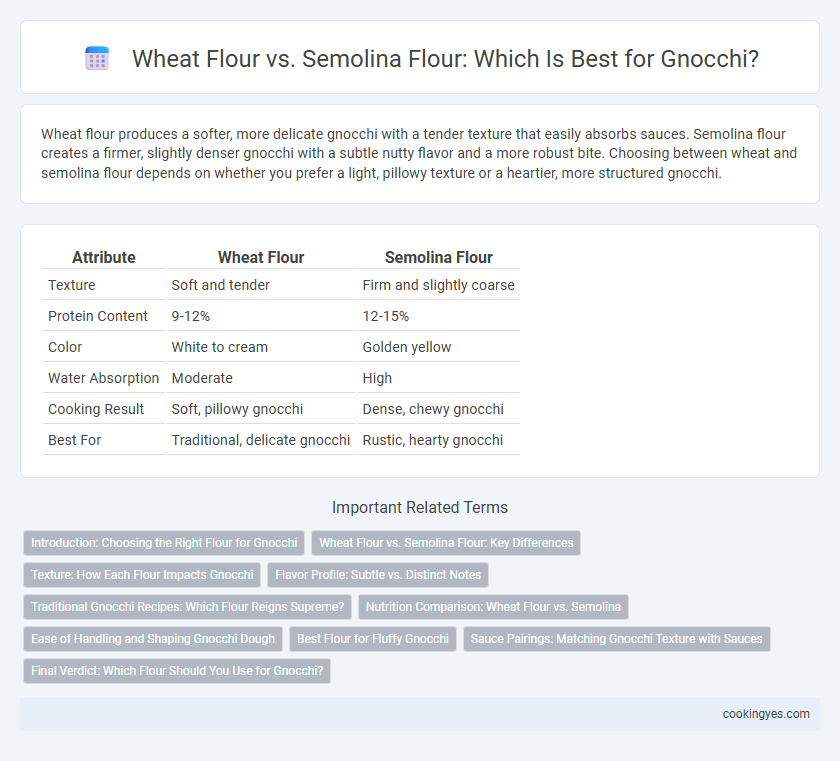Wheat flour produces a softer, more delicate gnocchi with a tender texture that easily absorbs sauces. Semolina flour creates a firmer, slightly denser gnocchi with a subtle nutty flavor and a more robust bite. Choosing between wheat and semolina flour depends on whether you prefer a light, pillowy texture or a heartier, more structured gnocchi.
Table of Comparison
| Attribute | Wheat Flour | Semolina Flour |
|---|---|---|
| Texture | Soft and tender | Firm and slightly coarse |
| Protein Content | 9-12% | 12-15% |
| Color | White to cream | Golden yellow |
| Water Absorption | Moderate | High |
| Cooking Result | Soft, pillowy gnocchi | Dense, chewy gnocchi |
| Best For | Traditional, delicate gnocchi | Rustic, hearty gnocchi |
Introduction: Choosing the Right Flour for Gnocchi
Wheat flour offers a soft, tender texture ideal for delicate gnocchi, while semolina flour provides a firmer, slightly coarse bite that holds shape well during cooking. Opting for wheat flour results in light, pillowy pieces, whereas semolina flour enhances durability and adds a subtle nuttiness to the dough. Understanding these flour characteristics allows chefs to tailor gnocchi texture and flavor to personal preference or specific recipes.
Wheat Flour vs. Semolina Flour: Key Differences
Wheat flour produces softer, pillowy gnocchi with a tender texture, while semolina flour creates a denser, firmer bite due to its coarse granules and higher protein content. Semolina flour's slightly nutty flavor enhances the gnocchi's taste and improves structural integrity during boiling, preventing them from becoming mushy. Choosing between wheat and semolina flour impacts the final gnocchi's texture and mouthfeel, with wheat flour prioritizing softness and semolina emphasizing firmness and flavor.
Texture: How Each Flour Impacts Gnocchi
Wheat flour creates a softer, more delicate gnocchi texture that easily absorbs sauces, while semolina flour produces a firmer, slightly chewy bite with a granular mouthfeel. The higher protein content in semolina provides structure and resilience, preventing gnocchi from becoming too mushy during boiling. Texture preferences often guide the choice: wheat flour suits tender, pillowy gnocchi, whereas semolina flour is ideal for gnocchi needing a denser, more robust consistency.
Flavor Profile: Subtle vs. Distinct Notes
Wheat flour in gnocchi offers a subtle, neutral flavor that allows the potato's natural sweetness to shine through, creating a delicate taste experience. Semolina flour contributes a distinct, nutty flavor with a slightly grainy texture that enhances the overall complexity of the gnocchi. Choosing between wheat and semolina flour impacts the final dish's flavor intensity and mouthfeel, tailoring it to either a smooth or more textured palate.
Traditional Gnocchi Recipes: Which Flour Reigns Supreme?
Traditional gnocchi recipes often debate the choice between wheat flour and semolina flour, with wheat flour offering a lighter, softer texture ideal for delicate gnocchi. Semolina flour, derived from durum wheat, provides a firmer, slightly denser bite and greater elasticity, which can help the gnocchi hold their shape better during boiling. Home cooks seeking classic Italian gnocchi typically favor wheat flour for its tender consistency, while semolina flour is preferred in regional variations aiming for a more robust, chewy result.
Nutrition Comparison: Wheat Flour vs. Semolina
Wheat flour contains a higher amount of protein and fiber compared to semolina flour, making it a more nutrient-dense option for gnocchi. Semolina flour, derived from durum wheat, has a coarser texture and provides more gluten, which helps create a firmer gnocchi with a slightly higher carbohydrate content. Both flours offer essential B vitamins, but wheat flour typically contains more iron and magnesium, contributing to enhanced nutritional value.
Ease of Handling and Shaping Gnocchi Dough
Using semolina flour for gnocchi dough results in a firmer texture that is easier to handle and shape, providing better resistance and preventing stickiness during rolling and cutting. Wheat flour produces a softer dough that can be more delicate and prone to tearing, making the shaping process more challenging, especially for beginners. Semolina's coarse granules create additional grip, facilitating the formation of uniform gnocchi shapes with well-defined ridges.
Best Flour for Fluffy Gnocchi
Semolina flour creates a firmer, denser gnocchi with a slightly grainy texture, making it suitable for dishes requiring gnocchi that hold shape well. Wheat flour, especially all-purpose or 00 flour, produces lighter, fluffier gnocchi due to its lower protein content and finer grind, enhancing tenderness and softness. For the best fluffy gnocchi, wheat flour is preferred as it ensures a delicate texture that melts in the mouth while maintaining structure.
Sauce Pairings: Matching Gnocchi Texture with Sauces
Gnocchi made with wheat flour yields a tender, pillow-like texture that pairs exceptionally well with delicate sauces such as sage butter or light tomato basil, allowing the softness to complement rather than overwhelm the dish. Semolina flour produces a firmer, slightly grainier gnocchi, ideal for robust, hearty sauces like Bolognese or creamy mushroom ragu that cling to the gnocchi's denser surface. Selecting the right flour enhances the gnocchi's texture and ensures optimal sauce adherence, elevating the overall flavor experience.
Final Verdict: Which Flour Should You Use for Gnocchi?
Semolina flour creates gnocchi with a firmer texture and slightly nutty flavor, ideal for holding shape in hearty sauces, while wheat flour produces softer, more pillowy gnocchi with a delicate mouthfeel preferred in traditional recipes. The choice between semolina and wheat flour depends on the desired texture and recipe authenticity, with semolina favored for firmer bites and wheat flour for melt-in-the-mouth softness. Ultimately, wheat flour remains the classic choice for authentic Italian gnocchi, whereas semolina is excellent for a more robust, textured variation.
Wheat flour vs Semolina flour for gnocchi mix Infographic

 cookingyes.com
cookingyes.com